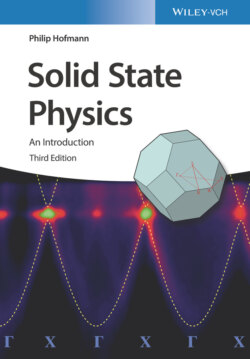Читать книгу Solid State Physics - Philip Hofmann - Страница 34
Problems
Оглавление1 1.1 Fundamental concepts: For the two‐dimensional crystal in Figure 1.15, find (a) the Bravais lattice and a primitive unit cell, (b) a nonprimitive, rectangular unit cell, and (c) the basis.Figure 1.15 A two‐dimensional crystal.
2 1.2 Real crystal structures: Show that the packing of spheres in a simple cubic lattice fills 52% of the available space.
3 1.3 Real crystal structures: Figure 1.16 shows the structures of a two‐dimensional hexagonal packed layer of atoms, a hcp crystal, a two‐dimensional sheet of carbon atoms arranged in a honeycomb lattice (graphene), and three‐dimensional graphite. (a) Draw a choice of vectors spanning the Bravais lattice for the hexagonal layer of atoms and for graphene, and compare them to each other. (b) Show that the basis for the hexagonal layer contains one atom, while the bases for graphene and the three‐dimensional hcp crystal contain two atoms. (c)* Choose lattice vectors for the Bravais lattice of graphite and show that the basis contains four atoms.Figure 1.16 (a) Two‐dimensional crystal structure of a hexagonal close‐packed layer of atoms. (b) Crystal structure of a three‐dimensional hcp crystal. (c) Two‐dimensional crystal structure of graphene. (d) Three‐dimensional crystal structure of graphite (strongly compressed along the direction). The lines are a mere guide to the eye, not indicating bonds or the size of the unit cell.
4 1.4 Real crystal structures: Consider the hcp lattice shown in Figure 1.16b. The Bravais lattice underlying the hcp structure is given by two vectors of length in one plane with an angle of between them and a third vector of length perpendicular to that plane. There are two atoms per unit cell. (a) Show that for the ideal packing of spheres, the ratio . (b)* Construct the reciprocal lattice. Does the fact that there are two atoms per unit cell in the hcp crystal have any relevance? Hint: Use the result of Problem 7.
5 1.5 X‐ray diffraction: (a) Determine the maximum wavelength for which constructive interference can be observed in the Bragg model for a simple cubic crystal with a lattice constant of 3.6 Å. (b) What is the energy of the X‐rays in electron volts? (c) If you were to perform neutron diffraction, what kinetic energy would the neutrons need to possess for their de Broglie wavelength to be same? (d) One could argue that if one would use X‐rays with twice the wavelength, one would still get a Bragg peak because then constructive interference would occur between the X‐rays reflected from every other plane. Why is this argument not valid? (e) One could describe the same crystal by using a unit cell that is a bigger cube of twice the side length, containing eight atoms instead of one. The lattice constant would then be 7.2 Å. Discuss how this different description would affect the X‐ray diffraction from the crystal.
6 1.6 The reciprocal lattice: Using the explicit definition of the reciprocal lattice in Eq. (1.16), show first that Eq. (1.17) is obeyed and then proceed, using this relation, to show that the reciprocal lattice defined by Eq. (1.16) does indeed meet the condition from Eq. (1.13).
7 1.7 The reciprocal lattice: For a two‐dimensional Bravais lattice(1.31) the reciprocal lattice is also two‐dimensional:(1.32) Often, the most practical way to construct the reciprocal lattice is to use the relation(1.33) which remains valid in the two‐dimensional case. Find the reciprocal lattices for the three cases displayed in Figure 1.17.Figure 1.17 Two‐dimensional Bravais lattices.
8 1.8 Lattice‐periodic functions: Figure 1.11 shows two lattice‐periodic functions and the Fourier coefficients generating these functions. The functions have been calculated from the coefficients using Eq. (1.20). (a) Write down the specific Fourier series corresponding to the lower half of Fig. 1.11 and make sure that the result is correct by plotting in the same interval as in the figure, from to (you may choose ). (b) Now try the reverse operation by numerically calculating the Fourier transform of the obtained . Display the resulting . You will find that it does not match the right‐hand side of Fig. 1.11: Instead of functions at the reciprocal lattice points, you will obtain quite broad peaks. Why is this so? What would be needed to narrow these peaks? Demonstrate how this can be achieved. (c)* Discuss the implications for the observed intensity in X‐ray diffraction. To this end, note that upon fulfilling the Laue condition, the diffracted intensity around a reciprocal lattice vector as in Eq. (1.26) corresponds to the squared norm of the scattering density's Fourier transformation.
9 1.9 Miller indices: We have stated that the reciprocal lattice vector is perpendicular to the lattice plane given by the Miller indices . (a) Verify that this is correct for the lattice planes drawn in Figure 1.9. (b)* Show that this statement is universally valid.
